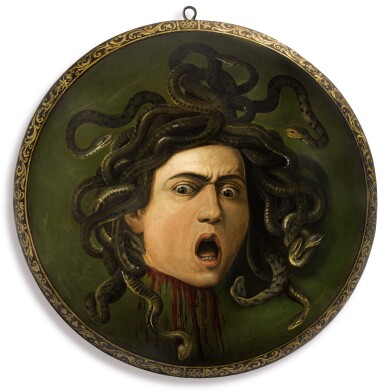Auctions
Buy Now
Collectibles & More
Books & Manuscripts
Master Paintings & Sculpture Day Sale
Master Paintings & Sculpture Day Sale

Auction Closed
January 30, 06:45 PM GMT
Estimate
70,000 - 90,000 USD
Lot Details
Description
AFTER MICHELANGELO MERISI, CALLED CARAVAGGIO, 19TH CENTURY
MEDUSA
oil on convex panel
diameter: 21⅝ in.; 55 cm.
Private collection, Tuscany.
From the bright green background to the convex and circular shape, this arresting image closely follows Caravaggio’s Head of Medusa, one of his most technically accomplished visual inventions. Today, that painting is preserved in the Uffizi Gallery, Florence, where it was widely copied as early as the nineteenth century. Caravaggio's original was commissioned around 1598 by Cardinal Francesco Maria del Monte as a gift for Ferdinando I de' Medici, Grand Duke of Tuscany.1 Soon after entering the Medici collection, it was moved to the grand-ducal Armory at the Uffizi, where it was part of a theatrical display of parade armor and weaponry, upheld as a shield by a jousting mannequin adorned in Persian armor, a gift from Abbas the Great, Shah of Persia. It is thought by some that Caravaggio also explored this same idea in an earlier and slightly smaller version datable to circa 1596, today in a private collection in Milan.2 The Gorgon Medusa is a recognizable figure from Greek mythology. With snakes for hair and a monstrous gaze, she turned anyone who looked directly at her to stone. Even after her death at the hands of Perseus, who used a mirror to avoid direct eye contact in his attack, her decapitated head still petrified those who dared look her in the eye.
In Caravaggio’s exploration of this composition, he used his own face for that of Medusa’s by using a convex mirror, in essence granting him immunity from her gaze. Though decapitated, she is rendered with palpable life, and her furrowed brow, silent scream, and shocked gaze, suggest the moment captured is the fleeting one between life and death. The anonymous artist of the present shield, who was likely active in the nineteenth century, has notably and carefully preserved all of these details of the Medici shield that have helped secure its intriguing fame for centuries.
1. 58 cm diameter, oil on canvas laid on panel, Florence, Uffizi Gallery, inv. no. 1351/1890.
2. 48 by 55 cm, oil on panel, signed Michel A F, private collection, Milan. See E. Zoffoli, ed., The First Medusa, Milan 2011, passim.